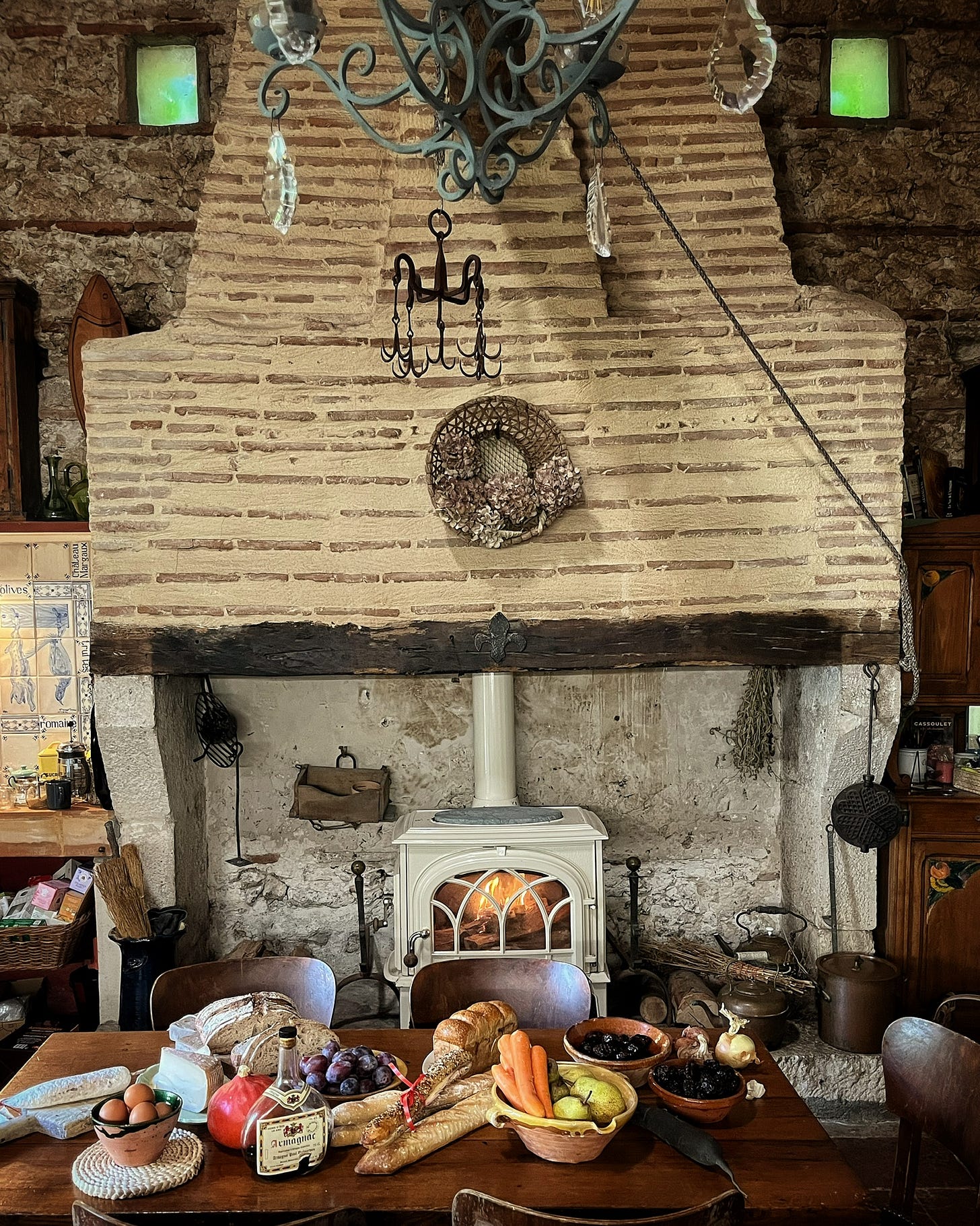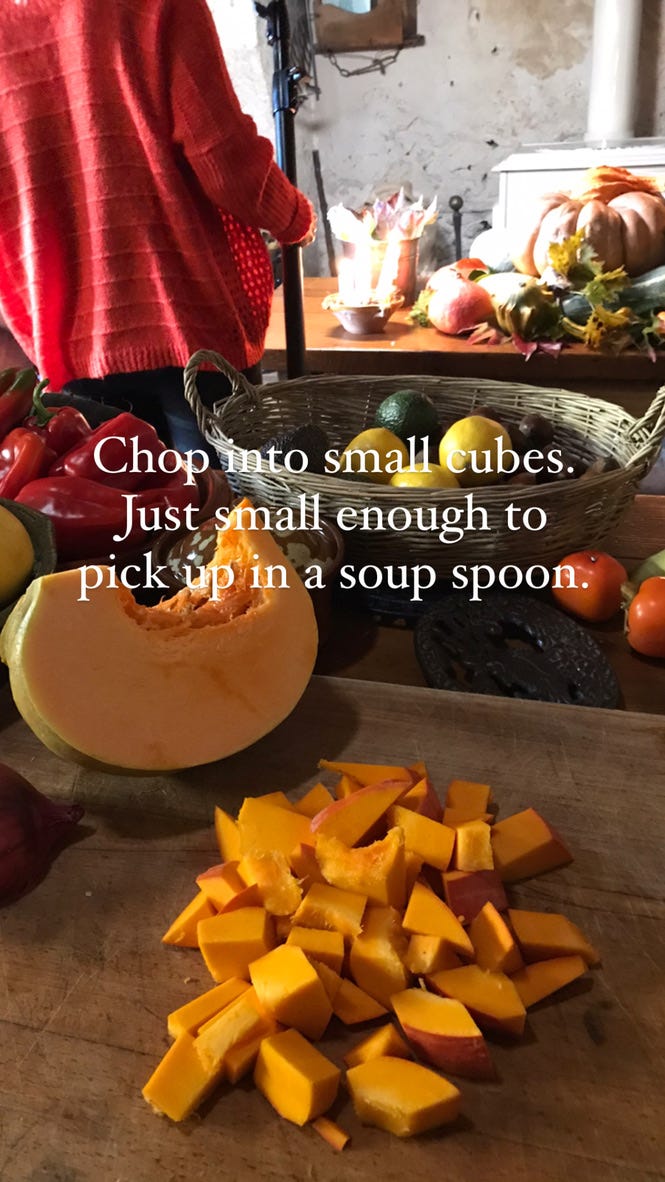Introduction to: Ma Cuisine—Field Notes from a French Kitchen
This next section of Champêtre, Ma Cuisine (My Kitchen or My Cooking), is where I share some of the classic French country dishes I love to cook in this old working kitchen when friends, new or old, stop by. Inspired by the old stone and brick walls and red terracotta tile floors, these are the out-of-hand recipes I make without looking at notes or a cookbook—the things I can cook with my eyes shut or while talking. I empty the market haul on the table—eggs, plums, cheese, potimarron squash, carrots, pears, prunes, brioche, and thin baguettes called “les ficelles” (strings) and decide what might be the best thing to make. Consider this the foundation for understanding French food in your own kitchen.
Every month, I will share my go-to favorite recipes and tips in the Ma Cuisine section. I have written many of these recipes, with variations and updates, and published them in books and articles over the years. Now colored by several decades of cooking in rural France, I am happy to share the little French trucs (tricks) I learned, and some I invented, to make my cooking life harmonious with my house and work life. Have a question? Don’t hesitate to ask in the comments or on the Chat feature of the Substack App.
At the end of these Champêtre: Ma Cuisine chapters, paid subscribers will have access to printable PDFs, a video, or other bonus material and full access to the complete Champêtre archive—all the time. If you’re not sure about subscribing, I am happy to comp anyone with a month-long subscription so you can get a taste of what’s to come; just drop me a note in the comments or send a reply email.
Let’s begin with an introduction to Champêtre: Ma Cuisine—my kitchen and how I cook.
Talking with your mouth full—teaching, cooking, and entertaining
I’ve always cooked. First, as a kid at home with my sister, after school, I played in my folks’ restaurant, and later, in my Army bride's newlywed home, I loved cooking for friends and family. Cupcakes and cornbread from boxed mixes were followed by stews and soups for groups of hungry students—spicy chili, spaghetti and meatballs, and chicken curries to fill a crowd.
It wasn’t until I started seriously traveling at 30 that I married my restaurant experience as a maitre d’ in a fine-dining California hotel restaurant with my own ease as a cook to become a professional chef on yachts—small and grand, private villas, and later on my charter canal barge, The Julia Hoyt. Those early years taught me simplicity and speed, how to shop- anywhere, and the importance of having a repertoire of a dozen dishes I could cook anywhere—with my eyes closed and while I talked and told stories. This would later play an essential factor in my teaching career.
Easy as one, two, three…
A starter, a main course, and a dessert—so easy—and just three things to master to build a reputation. Practice makes perfect, with variations, seasonal changes, and substitutions depending on place, space, and availability. But cooking in France, especially in this part of Southwest France, is easy because we have such great local ingredients. So, the first thing I must tattoo on your forearm is “Shopping is Cooking.” learn to be an expert shopper, first, then a good cook.
While I can always get farm-raised duck here in Gascony, it might not be so easy elsewhere. So don’t make that your go-to recipe. How about some good organic poultry instead? A well-raised chicken, some farm-fed pork, or even just the best organic, deep-yellow yolk farm eggs you can find can be your base. Start with the best you can find and afford. Here, I will use a whole roasting chicken—one that has pecked bugs and greens outside in the garden for a few months and has sturdy legs she can stand and run on from the foxes—a living, breathing part of the farmyard.
Next, look at the calendar (or browse through the bundle of three A Gascon Year e-books I am attaching for paid subscribers below) and find something that matches your local seasonal produce—apples now, pumpkins next, and strawberries in the spring. Make it simple and buy the best. Then, set aside time to play in your kitchen, repeating the recipe until you own it. As we start the Autumn harvest, I’ll grab a few just-picked apples, muscat grapes, pears, and a small squash or pumpkin.
So here’s my menu for a perfect Autumn day—
Soupe de Potimarron et Chataigne- squash and chestnut soup (video past the paywall)
Poulet Vigneronne with muscat grapes (video past paywall)
Harvest Tarte- Mixed fruit over a shortcrust foundation
La Soupe—Soup starts most meals in Gascony, at least until recently. This is not the soup and salad sort of lunch many North Americans want in a cafe and doesn’t really exist in France. Called the entrée or starter, this is the entrance to the meal and is often a mix of vegetables, pureed into a smooth velouté or left clear and brothy with some vermicelli pasta or toasted bread as croutons. You don't need to make much for this starter, not gallons of soup, but a 2-3 quart or liter saucepan will make a perfect two-ladle serving for four people— just enough.
Le Plat Principal—Next, the main course poultry braises, cooked in some liquid, and covered on the top of the stove. Vegetables will be cooking alongside the bird, so you don’t need another separate pan.
Le Dessert—While everything else is cooking, I’ll prepare something sweet to slip into the oven for dessert—a galette or open-face tarte of mixed fruit slices on a pastry shortcrust. Sprinkled with sugar, it will be browned, syrupy, and served warm just out of the oven with a dollop of crème fraïche or ice cream.
This is how I approach cooking a meal in my kitchen- plat principal first (cooks for 45-60), the starter next (cooks 25-30 minutes), and then the dessert, which will go into the oven just as everything else is done and be ready to serve warm from the oven (45 minutes or so.)
Are you ready for more?
Interested in more? The recipes and any videos for paying subscribers are attached below. Please join us for a year of cooking and living the Champêtre French Country life by subscribing or upgrading to paid status. Coming next— Classic French Cookbooks; Maiden France Vintage- all the old things we love—pottery, kitchen tools, barware, tableware, furniture, and linens—that make a home so French; L’Artisans- the French makers who keep the art in l’art de vivre—potters, painters, butchers, cheesemakers, weavers, textile designers, gilders, jewelry designers, chocolatiers, and so many more; à La Carte RoadTrips: take a morning drive or an overnight jaunt to discover those hidden places for les petites vacances. Merci!
Recipes below!








